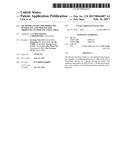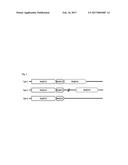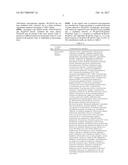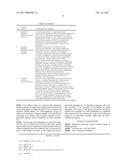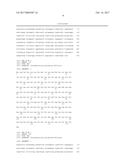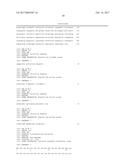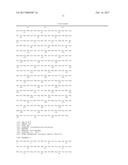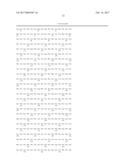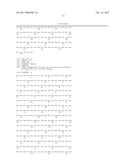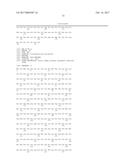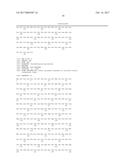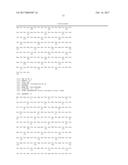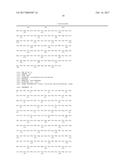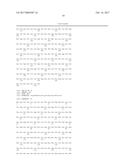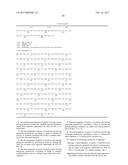Patent application title: MICROORGANISMS FOR PRODUCING PUTRESCINE AND PROCESS FOR PRODUCING PUTRESCINE USING THEM
Inventors:
Kyoung-Min Lee (Seoul, KR)
Hongxian Li (Seoul, KR)
Su-Jin Park (Seoul, KR)
Young Lyeol Yang (Seoul, KR)
Hye-Won Um (Gyeonggi-Do, KR)
Hye-Won Um (Gyeonggi-Do, KR)
Hee Kyoung Jung (Seoul, KR)
IPC8 Class: AC12N120FI
USPC Class:
1 1
Class name:
Publication date: 2017-02-16
Patent application number: 20170044487
Abstract:
The present invention relates to a recombinant microorganism capable of
producing putrescine at high yield due to inactivated activity of a
protein having an amino acid sequence represented by SEQ ID NO: 2 in the
microorganism, and a method of producing putrescine using the
microorganism.Claims:
1. An isolated microorganism of genus Corynebacterium having putrescine
productivity, wherein a protein having an amino acid sequence represented
by SEQ ID NO: 2 is inactivated.
2. The microorganism of genus Corynebacterium having putrescine productivity according to claim 1, wherein an activity of ornithine decarboxylase (ODC) is further introduced into the microorganism.
3. The microorganism of genus Corynebacterium having putrescine productivity according to claim 2, wherein the ODC has an amino acid sequence represented by SEQ ID NO: 10.
4. The microorganism of genus Corynebacterium having putrescine productivity according to claim 1, wherein acetyltransferase activity is further inactivated in the microorganism.
5. The microorganism of genus Corynebacterium having putrescine productivity according to claim 4, wherein the acetyltransferase comprises an amino acid represented by SEQ ID NO: 15 or 16.
6. The microorganism of genus Corynebacterium having putrescine productivity according to claim 1, wherein the microorganism is Corynebacterium glutamicum.
7. A method of producing putrescine, comprising: culturing a microorganism of genus Corynebacterium having putrescine productivity wherein a protein having an amino acid sequence represented by SEQ ID NO: 2 is inactivated, in a culture medium; and separating putrescine from the cultured microorganism or the culture medium obtained from the above step.
8. The method of producing putrescine according to claim 7, wherein the microorganism of genus Corynebacterium is Corynebacterium glutamicum.
Description:
TECHNICAL FIELD
[0001] The present invention relates to a recombinant microorganism for producing putrescine and a method of producing putrescine using the same.
BACKGROUND ART
[0002] Biogenic amines (BAs) are nitrogen compounds mainly produced by decarboxylation of amino acids, amination of aldehyde and ketone, and transamination. Such biogenic amines are low molecular weight compounds, which are synthesized during metabolism of microorganisms, plants, and animals, and thus are known as components easily found in cells thereof. Especially, polyamine such as spermidine, spermine, putrescine (or 1,4-butanediamine), cadaverine, etc., are substances present in most living cells.
[0003] Among them, putrescine is an important raw material which synthesizes polyamine nylon-4,6 by reacting with adipic acid, and is produced mainly by chemical synthesis through acrylonitrile and succinonitrile from propylene.
[0004] In addition, a method for producing putrescine at high concentration by transformation of E. coli and genus Corynebacterium has been disclosed (International Publication No. WO06/005603; International Publication No. WO09/125924; Qian Z D et al., Biotechnol. Bioeng. 104(4): 651-662, 2009; Schneider et al., Appl. Microbiol. Biotechnol. 88(4): 859-868, 2010; and Schneider et al., Appl. Microbiol. Biotechnol. 95: 169-178, 2012). Further, research on putrescine transporter regarding E. coli, yeast, plant and animal cells has been actively conducted (K Igarashi, Plant Physiol. Biochem. 48: 506-512, 2010).
[0005] Meanwhile, the present inventors demonstrated that membrane proteins encoding NCgl2522 function as a putrescine exporter in a microorganism of genus Corynebacterium, which includes a putrescine synthesis pathway, and confirmed that putrescine may be produced at a high yield by enhancing NCgl2522 activity from to the endogenous activity thereof (KR Patent Application No. 10-2013-0030020)
[0006] In addition, NCgl2523 gene is a multidrug-resistance-related transcription factor which belongs to TetR family, and is known to act as an NCgl2522 expression inhibitor (Hirochi et. al. J Biol. Chem. 280:46, 38711-38719. 2005).
[0007] In this regard, the present inventors have continuously conducted research and confirmed enhanced putrescine production by depletion of NCgl2523 which constitutes NCgl2522 operon, in the manner similar to the effects of enhancing NCgl2522 activity, thereby completing the present invention.
DISCLOSURE
Technical Problem
[0008] An objective of the present invention is to provide a recombinant microorganism capable of producing putrescine at high yield.
[0009] Another objective of the present invention is to provide a method of producing putrescine at high yield using the microorganism.
Technical Solution
[0010] In one aspect to achieve the above objectives, the present invention provides a microorganism of genus Corynebacterium having putrescine productivity, in which a protein having an amino acid sequence represented by SEQ ID NO: 2 is inactivated
[0011] In one exemplary embodiment, the present invention provides a microorganism of genus Corynebacterium having putrescine productivity, wherein an activity of ornithine decarboxylase (ODC) is further introduced into the microorganism.
[0012] In another exemplary embodiment, the present invention provides a microorganism of genus Corynebacterium having putrescine productivity, in which the ODC has an amino acid sequence represented by SEQ ID NO: 10.
[0013] In still another exemplary embodiment, the present invention provides a microorganism of genus Corynebacterium having putrescine productivity, wherein acetyltransferase activity is further inactivated in the microorganism.
[0014] In still another embodiment, the present invention provides a microorganism of genus Corynebacterium having putrescine productivity, wherein the acetyltransferase comprises an amino acid represented by SEQ ID NO: 15 or 16.
[0015] In still another embodiment, the present invention provides a microorganism of genus Corynebacterium having putrescine productivity, in which the microorganism is Corynebacterium glutamicum.
[0016] In another aspect, the present invention provides a method of producing putrescine including:
[0017] i) culturing a microorganism of genus Corynebacterium having putrescine productivity wherein a protein having an amino acid sequence represented by SEQ ID NO: 2 is inactivated in a culture medium; and
[0018] ii) separating putrescine from a cultured microorganism or the culture medium obtained from the above step.
[0019] In an exemplary embodiment, the present invention provides a method of producing putrescine, in which the microorganism of genus Corynebacterium is Corynebacterium glutamicum.
[0020] Hereinafter, the present invention will be described in detail.
[0021] In one aspect, the present invention relates to a microorganism of genus Corynebacterium having putrescine productivity, wherein a protein having an amino acid sequence represented by SEQ ID NO: 2, thus NCgl2523, is inactivated
[0022] As used herein, the term "NCgl2523" refers to a multidrug-resistance-related transcription factor which belongs to TetR family, and is known to act as an Ncgl2522 expression inhibitor (Hirochi et. al., J Biol. Chem. 280(46): 38711-38719, 2005).
[0023] In the present invention, NCgl2523 is a protein having an amino acid of SEQ ID NO: 2 or an amino acid sequence having 70% or more, more specifically 80% or more, even more specifically 90% or more, much more specifically 98% or more, and most specifically 99% or more homology to the sequence, and is not limited thereto as long as it is a protein having the activity of an NCgl2522 expression inhibitor.
[0024] Further, because amino acid sequences of proteins showing the activity may differ depending on species or strain of microorganisms, it is not limited thereto. It is obvious that a protein having an amino acid sequence in which the sequence is partially deleted, modified, substituted, or inserted is included in the scope of the present invention, as long as a sequence having homology to the sequence shows biological activity practically equivalent or corresponding to a protein of SEQ ID NO: 2.
[0025] As used herein, the term "homology" refers to similarity between given amino acid sequences or nucleotide sequences and may be represented in percentage. Herein, the homology sequence which have identical or similar activity with a given amino acid sequence or nucleotide sequence is indicated by "% homology". For example, homology may be examined by using conventional software calculating mediated parameters such as score, identity, similarity, etc., and more specifically using BLAST 2.0, or by comparing sequences via Southern hybridization under defined stringent conditions. Appropriate hybridization conditions may be defined by the scope of the art, and may be determined by one of ordinary skill in the art using known methods (i.e., J. Sambrook et al., Molecular Cloning, A Laboratory Manual, 2nd Edition, Cold Spring Harbor Laboratory press, Cold Spring Harbor, N.Y., 1989; F. M. Ausubel et al., Current Protocols in Molecular Biology, John Wiley & Sons, Inc., New York).
[0026] As long as it has an activity similar to those of NCgl2523 proteins, a polynucleotide encoding NCgl2523 of the present invention may include an amino acid sequence of SEQ ID NO: 2, or a polynucleotide encoding a protein having 70% or more, specifically 80% or more, more specifically 90% or more, much more specifically 95% or more homology thereto, much more specifically 98% or more, and most specifically 99% or more homology to the sequence, and may especially include a nucleotide sequence of SEQ ID NO: 1 or 3.
[0027] Further, a polynucleotide encoding NCgl2523 of the present invention may be hybridized in stringent conditions with a probe of a nucleotide sequence represented by SEQ ID NO: 1 or 3, or a probe derived from the nucleotide sequence, and may be a variant encoding functionally normal NCgl2523. As used herein, the term "stringent conditions" refers to conditions which enable a specific hybridization between polynucleotides. For example, such stringent conditions are described in detail in literature (i.e., J. Sambrook et al., Molecular Cloning, A Laboratory Manual, 2nd Edition, Cold Spring Harbor Laboratory press, Cold Spring Harbor, N.Y., 1989; F. M. Ausubel et al., Current Protocols in Molecular Biology, John Wiley & Sons, Inc., New York).
[0028] In the present invention, it was confirmed that when NCgl2523, which constitutes an NCgl2522 operon, was deleted in a microorganism of genus Corynebacterium having putrescine productivity, putrescine production increased, similarly to when NCgl2522 activity was enhanced. In this regard, the present invention may provide a recombinant microorganism showing putrescine production at a high yield by inhibiting NCgl2522 expression resulting from inactivating NCgl2523 activity. Therefore, as disclosed in the embodiment of the present invention, by inactivating the corresponding NCgl2523 and genes encoding amino acids similar thereto, putrescine productivity may be enhanced in a microorganism having amino acids having sequences similar to that of NCgl2523, in which such amino acids consist of NCgl2522 and an operon, or a microorganism in which NCgl2523 acts similarly as an NCgl2522 expression modulator.
[0029] As used herein, the term "inactivation" refers to not expressing a gene encoding a corresponding polypeptide, showing a certain reduction in gene expression, not producing a corresponding functional polypeptide, even when expressed.
[0030] In addition, inactivation refers not only to completely inactivating a gene encoding a corresponding polypeptide, but also to a weakened or significantly reduced expression compared to the wild-type, thereby practically not expressing the gene. Therefore, gene inactivation may be complete (knockout) or partial (for example, a hypomorph which shows gene expression below the normal level, or a product of a mutant gene which shows partial reduction in activity in effect of a hymorph).
[0031] In particular, in the present invention, inactivation of NCgl2523 may be induced by:
[0032] 1) a partial or complete deletion of a polynucleotide encoding the protein;
[0033] 2) modification of a regulatory sequence to decrease an expression of the polynucleotide;
[0034] 3) modification of the polynucleotide sequence on chromosome in order to weaken the protein activity; and
[0035] 4) a combination thereof,
[0036] without being particularly limited thereto.
[0037] 1) a partial or complete deletion of a polynucleotide encoding the protein may be performed by replacing a polynucleotide encoding endogenous target proteins or chromosomes with a partially removed polynucleotide or a marker gene using a vector for chromosomal insertion into a microorganism. The "partial" may vary depending on the type of polynucleotides, but specifically refers to 1 to 300, more specifically to 1 to 100, and even more specifically 1 to 50.
[0038] As used herein, the term "vector" refers to a DNA construct including a nucleotide sequence encoding a desired protein, which is operably linked to an appropriate expression regulatory sequence to express the desired protein in a suitable host cell. The regulatory sequence includes a promoter that can initiate transcription, an optional operator sequence for regulating the transcription, a sequence encoding a suitable mRNA ribosome-binding site, and a sequence regulating the termination of transcription and translation. After the vector is transformed into a suitable host cell, it can replicate or function independently of the host genome, and can be integrated into the genome itself.
[0039] The vector used in the present invention is not particularly limited, as long as it is able to replicate in host cells, and any vector known in the art may be used. Examples of conventional vectors may include a natural or recombinant plasmid, cosmid, virus, and bacteriophage. For example, pWE15, M13, MBL3, MBL4, IXII, ASHII, APII, t10, t11, Charon4A, Charon21A, etc., may be used as a phage vector or cosmid vector, and pBR types, pUC types, pBluescriptII types, pGEM types, pTZ types, pCL types, pET types, etc., may be used as a plasmid vector. A vector usable in the present invention is not particularly limited, and any known expression vector may be used. Specifically, pDZ, pACYC177, pACYC184, pCL, pECCG117, pUC19, pBR322, pMW118, or pCC1BAC vector may be used.
[0040] Further, the polynucleotide encoding a desired protein in chromosomes may be replaced by a mutated polynucleotide using a vector for chromosomal insertion. The insertion of the polynucleotide into the chromosome may be performed by any method known in the art such as homologous recombination, without being particularly limited thereto.
[0041] As used herein, the term "transformation" refers to introduction of vectors including a polynucleotide encoding target proteins into host cells so that proteins encoded by the polynucleotide are expressed in host cells. As long as the transformed polynucleotide can be expressed in a host cell, it includes all whether it is integrated into chromosomes of host cells or exists extrachromosomally. Further, the polynucleotide includes DNA and RNA encoding target proteins. The polynucleotide may be introduced in any form, as long as it can be introduced into host cells and expressed therein. For example, the polynucleotide may be introduced into host cells in the form of an expression cassette which is a gene construct including all elements required for its autonomous expression. Typically, the expression cassette includes a promoter operably linked to the polynucleotide, transcriptional termination signals, ribosome-binding sites, or translation termination signals. The expression cassette may be in the form of a self-replicable expression vector. Also, the polynucleotide may be introduced into host cells as it is and operably linked to sequences required for expression in host cells, without being limited thereto.
[0042] Further, the term "operably linked" refers to a functional linkage between a polynucleotide sequence encoding desired proteins and a promoter sequence which initiates and mediates transcription of the polynucleotide sequence.
[0043] Next, 2) modification of a regulatory sequence to decrease an expression of the polynucleotide may be performed by inducing modification in a regulatory sequence by deletion, insertion, non-conservative or conservative substitution, or a combination thereof in a nucleotide sequence or replacing with a nucleotide with a weaker activity, in order to weaken the activity of the regulatory sequence, without being particularly limited thereto. The regulatory sequence may include a promoter, an operator sequence, a sequence encoding ribosome-binding site, and a sequence regulating termination of transcription and translation, without being limited thereto.
[0044] Further, 3) modification of the polynucleotide sequence on chromosome may be performed by inducing modification in a regulatory sequence deletion, insertion, non-conservative or conservative substitution, or a combination thereof in a nucleotide sequence, or replacing with a nucleotide with a weaker activity, in order to weaken the protein activity, without being limited thereto,
[0045] As used herein, the term "a microorganism having putrescine productivity" or "a microorganism producing putrescine" refers to a microorganism naturally having putrescine productivity or a microorganism, in which putrescine productivity is incorporated into a parent strain having no putrescine productivity.
[0046] The microorganism producing putrescine may be, without being particularly limited thereto, a microorganism having improved productivity of ornithine to be used as a raw material for putrescine biosynthesis, in which the microorganism is modified to have higher activities of acetylglutamate synthase converting glutamate to acetylglutamate (N-acetylglutamate) or ornithine acetyltransferase (ArgJ) converting acetyl ornithine to ornithine, acetylglutamate kinase (ArgB) converting acetyl glutamate to acetylglutamyl phosphate (N-acetylglutamyl phosphate), acetyl-gamma-glutamyl phosphate reductase (ArgC) converting acetyl glutamyl phosphate to acetyl glutamate semialdehyde (N-acetyl glutamate semialdehyde), or acetylornithine aminotransferase (ArgD) converting acetyl glutamate semialdehyde to acetylornithine (N-acetylornithine), compared to the endogenous activity, in order to enhance the biosynthesis pathway from glutamate to ornithine glutamate.
[0047] Further, the microorganism is modified to inactivate endogenous activity of ornithine carbamoyltransfrase (ArgF) involved in arginine synthesis from ornithine, glutamate exporter (NCgl1221), and/or acetyltransferase which acetylizes putrescine and/or is modified to introduce activity of ornithine decarboxylase (ODC).
[0048] Here, the ornithine carbamoyltransfrase (ArgF), glutamate exporter (NCgl1221), ornithine decarboxylase (ODC), acetyl-gamma-glutamyl-phosphate reductase (ArgC), acetyl glutamate synthase or ornithineacetyltransferase (ArgJ), acetylglutamate kinase (ArgB), and acetylornithine aminotransferase (ArgD), may include specifically an amino acid sequence each represented by SEQ ID NO: 8, 9, 10, 11, 12, 13, and 14 or an amino acid sequence having 70% or more, more specifically 80% or more, even more specifically 90% or more homology to the sequence, without being particularly limited thereto.
[0049] Further, an acetyltransferase, which acetylizes putrescine, may include specifically an amino acid sequence represented by SEQ ID NO: 15 or 16 or an amino acid sequence having 70% or more, more specifically 80% or more, even more specifically 90% or more homology to the sequence, without being particularly limited thereto.
[0050] In particular, an increase in activity in the present invention may be carried out by:
[0051] 1) an increase in the copy number of polynucleotides encoding the enzyme;
[0052] 2) modification of a regulatory sequence to increase the polynucleotide expression;
[0053] 3) modification of a polynucleotide sequence on chromosome to enhance activity of the enzyme; or
[0054] 4) modification to enhance by a combination thereof,
[0055] without being limited thereto.
[0056] 1) an increase in the copy number of polynucleotides may be performed in the form operably liked to a vector, or by chromosomal insertion into host cells, without being particularly limited thereto. In particular, it may be performed by introducing a vector, to which a polynucleotide encoding an enzyme of the present invention enzyme operably linked and which may be copied and function independently of host cells into host cells, or by introducing a vector to which the polynucleotide is operably linked and which is able to insert the polynucleotide into choromosomes in host cells into host cells, thereby increasing the copy number of polynucleotides in chromosomes of the host cells.
[0057] Next, 2) modification of a regulatory sequence to increase the polynucleotide expression may be performed by inducing modification in a sequence by deletion, insertion, non-conservative or conservative substitution or a combination thereof, or replacing with a nucleotide sequence with enhanced activity, in order to enhance the activity the regulatory sequence, without being particularly limited thereto. The regulatory sequence may include a promoter, an operator sequence, a sequence encoding a ribosome-binding site, a sequence regulating termination of transcription and translation, etc., without being particularly limited thereto.
[0058] In the upstream of the polynucleotide expression unit, a strong heterologous promoter may be linked instead of the original promoter. Examples of the strong promoter are CJ7 promoter, lysCP1 promoter, EF-Tu promoter, groEL promoter, aceA or aceB promoter, etc., and more specifically, may be operably linked to a Corynebacterium-originated promoter, lysCP1 promoter (WO2009/096689), or CJ7 promoter (KR Patent No. 0620092 and WO2006/065095) and increase an expression of a polynucleotide encoding the enzyme, but are not limited thereto.
[0059] Furthermore, 3) modification of a polynucleotide sequence on chromosome may be performed by inducing modification in a regulatory sequence by deletion, insertion, non-conservative or conservative substitution or a combination there of in a nucleotide sequence, or by replacing with a polynucleotide sequence which is modified to have enhanced activity, in order to enhance activity of the polynucleotide sequence, without being particularly limited thereto.
[0060] Further, inactivation of ornithine carbamoyltransfrase (ArgF), glutamate exporter, and acetyl transferase may be performed by methods of inactivating NCgl2523 as previously mentioned:
[0061] 1) a partial or complete deletion of a polynucleotide encoding the protein;
[0062] 2) modification of a regulatory sequence to decrease an expression of the polynucleotide;
[0063] 3) modification of the polynucleotide sequence on chromosome in order to weaken the protein activity; and
[0064] 4) a combination thereof,
[0065] without being particularly limited thereto.
[0066] Meanwhile, a microorganism of the present invention is a microorganism having putrescine productivity and includes prokaryotic microorganisms expressing proteins including an amino acid represented by SEQ ID NO: 2. Examples of such are Escherichia sp., Shigella sp., Citrobacter sp., Salmonella sp., Enterobacter sp., Yersinia sp., Klebsiella sp., Erwinia sp., Corynebacterium sp., Brevibacterium sp., Lactobacillus sp., Selenomanas sp., Vibrio sp., Pseudomonas sp., Streptomyces sp., Arcanobacterium sp., Alcaligenes sp. microorganisms, etc. In particular, a microorganism of the present invention may be a microorganism of genus Corynebacterium, and more specifically Corynebacterium glutamicum, but is not limited thereto.
[0067] In one exemplary embodiment, the present invention uses strains having high-concentration putrescine productivity due to an enhanced putrescine biosynthesis pathway from glutamate, which are microorganisms of genus Corynebacterium deposited under Accession Nos. KCCM11138P (KR Patent No. 2012-0064046) and KCCM11240P (KR Patent No. 2012-0003634).
[0068] In another exemplary embodiment, the present invention uses KCCM11138P and KCCM11240P, which are putrescine-producing strains derived from Corynebacterium glutamicum ATCC13032, and DAB12-a (KR Patent No. 2013-0082478) and DAB12-b (KR No. 2013-0082478; DAB12-.DELTA.NCgl1469), which are putrescine-producing strains derived from Corynebacterium glutamicum ATCC13869, each having identical genotypes. ATCC13869 strain may be obtained from American Type Culture Collection (ATCC).
[0069] In particular, the present inventors named a microorganism of genus Corynebacterium having enhanced putrescine productivity due to inactivation of NCgl2523 activity in Corynebacterium glutamicum KCCM11240P, which is a putrescine-producing strain, as Corynebacterium glutamicum CC01-0844, and deposited it to Korean Culture Center of Microorganisms (KCCM) under Budapest Treaty as Accession No. KCCM11520P on Feb. 25, 2014.
[0070] In another aspect, the present invention provides a method of producing putrescine including:
[0071] i) culturing a microorganism of genus Corynebacterium having enhanced putrescine productivity wherein a protein having an amino acid sequence represented by SEQ ID NO: 2 is inactivated in a culture medium; and
[0072] ii) separating putrescine from the cultured microorganism or the culture medium obtained from the above step.
[0073] In the method, culturing the microorganism may be performed by known batch culturing methods, continuous culturing methods, fed-batch culturing methods, etc., without being particularly limited thereto. Here, culture conditions may be maintained at optimal pH (e.g., pH 5 to 9, specifically pH 6 to 8, and most specifically pH 6.8) using basic compounds (e.g., sodium hydroxide, potassium hydroxide, or ammonia) or acidic compounds (e.g., phosphoric acid or sulfuric acid), and at an aerobic condition by oxygen or oxygen-containing gas mixture to a cell culture, without being particularly limited thereto. The culture temperature may be maintained at 20.degree. C. to 45.degree. C. and specifically at 25.degree. C. to 40.degree. C., and cultured for about 10 to 160 hours. Putrescine produced by the cultivation may be exported to the culture medium or remain in cells.
[0074] Further, the used culture medium may include sugar and carbohydrate (e.g., glucose, sucrose, lactose, fructose, maltose, molasse, starch, and cellulose), oil and fat (e.g., soybean oil, sunflower seed oil, peanut oil, and coconut oil), fatty acid (e.g., palmitic acid, stearic acid, and linoleic acid), alcohol (e.g., glycerol and ethanol), and organic acid (e.g., acetic acid) individually or in combination as a carbon source; nitrogen-containing organic compounds (e.g., peptone, yeast extract, meat juice, malt extract, corn solution, soybean meal powder, and urea), or inorganic compounds (e.g., ammonium sulfate, ammonium chloride, ammonium phosphate, ammonium carbonate, and ammonium nitrate) individually or in combination as a nitrogen source; potassium dihydrogen phosphate, dipotassium phosphate, or sodium-containing salt corresponding thereto individually or in combination as a phosphorus source; and other essential growth-stimulating substances including metal salts (e.g., magnesium sulfate or iron sulfate), amino acids, and vitamins, without being limited thereto.
[0075] Separating putrescine produced in the culturing step of the present invention may be performed using a suitable method known in the art depending on culturing methods such as batch, continuous or fed-batch culturing methods, etc., thereby collecting desired amino acids from the culture.
Advantageous Effects
[0076] A microorganism of genus Corynebacterium having enhanced putrescine productivity of the present invention is modified to inactivate activity of a protein including an amino acid sequence of SEQ ID NO: 2, thereby inducing enhanced activity of a protein which is expected to be a putrescine exporter, specifically NCgl2522, and increasing putrescine export to the outside of cells, and thus may effectively produce putrescine.
DESCRIPTION OF DRAWINGS
[0077] FIG. 1 is a schematic diagram showing combined structures of NCgl2523 and the adjacent. In particular, FIG. 1 is a schematic diagram showing a combined structure of NCgl2522-NCgl2523-NCgl2524 which is a combined structure of adjacent genes of a microorganism including NCgl2523 (Type 1); a structure of combined NCgl2522-NCgl2523 and individual NCgl2524 (Type 2); or a combined structure of NCgl2522-NCgl2523 (Type 3).
MODE FOR INVENTION
[0078] Hereinafter, the present invention will be described in more detail with reference to Examples. However, the Examples are for illustrative purposes only, and thus the scope of the present invention is not intended to be limited by the Examples.
Example 1
Preparation of NCgl2523-Deleted Strains and Verification of its Putrescine Productivity
<1-1> Preparation of NCgl2523-Deleted Strains in ATCC13032-Derived Putrescine-Producing Strains
[0079] In order to verify whether deletion of NCgl2523 derived from Corynebacterium glutamicum ATCC13032 has an effect in putrescine productivity, vectors for deletion of a gene encoding NCgl2523 were prepared.
[0080] In particular, based on the nucleotide sequence of a gene encoding NCgl2523 represented by SEQ ID NO: 1, a pair of primers of SEQ ID NOs: 4 and 5 for obtaining homologous recombination fragments at the N-terminal region of NCgl2523, and a pair of primers of SEQ ID NOs: 6 and 7 for obtaining homologous recombination fragments at the C-terminal region of NCgl2523 were constructed as shown in Table 1.
TABLE-US-00001 TABLE 1 NCg12523-del-F1_ CGGGATCCATGACTACCTCGCAGCGTTTC BamHI (SEQ ID NO: 4) NCg12523-del-R1_ ACGCGTCGACCTAGTGCGCATTATTGGCTCC SalI (SEQ ID NO: 5) NCg12523-del-F2_ ACGCGTCGACAGCCATGCTGGAAACAATTCTCG SalI (SEQ ID NO: 6) NCg12523-del-R2_ XbaI CTAGTCTAGAGAGAGCTGCGCATAGTACTG (SEQ ID NO: 7)
[0081] PCR was performed using the genomic DNA of Corynebacterium glutamicum ATCC13032 as a template and two pairs of primers, thereby amplifying PCR fragments at the N-terminal and C-terminal regions of NCgl2523 gene. Desired fragments were obtained via electrophoresis of the PCR fragments. Here, PCR reaction was repeated for 30 cycles including 30 seconds of denaturation at 95.degree. C., 30 seconds of annealing at 55.degree. C., and 30 seconds of extension at 72.degree. C. The thus obtained fragments of the N-terminal and C-terminal regions were treated with restriction enzymes BamHI and SalI, and restriction enzymes SalI and XbaI, respectively. The treated fragments were cloned into pDZ vectors treated with restriction enzymes BamHI and XbaI, thereby constructing pDZ-1'NCgl2523(K/O) plasmids.
[0082] The pDZ-1'NCgl2523 (K/O) plasmids were each transformed into KCCM11138P (KR Patent No. 10-1348461) and KCCM11240P (KR Patent No. 2013-0082478) by electroporation to obtain transformants. For colony formation, the transformants were plated and cultured on BHIS plate media (Braine heart infusion (37 g/L), sorbitol (91 g/L), and agar (2%)) containing kanamycin (25 .mu.g/mL) and X-gal(5-bromo-4-chloro-3-indolin-D-galactoside). From the formed colonies, blue colonies were selected as strains introduced with pDZ-1'NCgl2523(K/O) plasmids.
[0083] The selected strains is cultured in a CM medium (glucose 10 g/L, polypeptone (10 g/L), yeast extract (5 g/L), beef extract (5 g/L), NaCl (2.5 g/L), urea (2 g/L), and pH 6.8) at 30.degree. C. for 8 hours. After serial dilution of each cell culture from 10.sup.4 to 10.sup.-10, the diluted samples were plated and cultured in an X-gal-containing solid medium to form colonies. From the formed colonies, white colonies, which appeared at a relatively low frequency, were finally selected as strains with deletion of a gene encoding NCgl2523 by a secondary crossover.
[0084] PCR was performed using a pair of primers of SEQ ID NOs: 4 and 7 to confirm deletion of a gene encoding NCgl2523 in the finally selected strains. The Corynebacterium glutamicum mutants were each named as KCCM11138P .DELTA.NCgl2523 and KCCM11240P .DELTA.NCgl2523.
<1-2> Preparation of NCgl2523-Deleted Strains in ATCC13869-Derived Putrescine-Producing Strains
[0085] NCgl2523-deleted strains were constructed from DAB12-a (KR Patent No. 2013-0082478) and DAB12-b (KR Patent No. 2013-0082478; DAB12-a .DELTA.NCgl1469), which are putrescine-producing strains derived from Corynebacterium glutamicum ATCC13869.
[0086] In particular, in order to verify a sequence of NCgl2523 gene and the expressed protein therefrom derived from Corynebacterium glutamicum ATCC13869, PCR was performed using genomic DNA of Corynebacterium glutamicum ATCC13869 as a template and a pair of primers of SEQ ID NOs: 4 and 7. Here, PCR reaction was repeated for 30 cycles including 30 seconds of denaturation at 95.degree. C., 30 seconds of annealing at 55.degree. C., and 1 minute 30 seconds of extension at 72.degree. C.
[0087] By separating the thus obtained PCR products via electrophoresis and analyzing by sequencing, a gene encoding NCgl2523 derived from Corynebacterium glutamicum ATCC13869 was found to include a nucleotide sequence represented by SEQ ID NO: 3. Further, an amino acid sequence of proteins encoded by the gene was compared to an amino acid sequence of NCgl2523 (SEQ ID NO: 2) derived from Corynebacterium glutamicum ATCC13032, and the result showed 100% homology.
[0088] In order to delete a gene encoding NCgl2523 derived from Corynebacterium glutamicum ATCC13869, PCR was performed using genomic DNA of Corynebacterium glutamicum ATCC13869 as a template and two pairs of primers described in Table 1 as in Example <1-1>, and PCR fragments of the N-terminal C-terminal regions of NCgl2523 gene were amplified, thereby obtaining desired fragments via electrophoresis. Here, PCR reaction was repeated for 30 cycles including 30 seconds of denaturation at 95.degree. C., 30 seconds of annealing at 55.degree. C., and 30 seconds of extension at 72.degree. C. The obtained fragments of the N-terminal and C-terminal regions were treated with restriction enzymes BamHI and SalI, and restriction enzymes SalI and XbaI, respectively. The treated fragments were cloned into pDZ vectors treated with restriction enzymes BamHI and XbaI, thereby constructing pDZ-2'NCgl2523(K/O) plasmids.
[0089] By transforming pDZ-2'NCgl2523 (K/O) into each of Corynebacterium glutamicum DAB12-a and DAB12-b in the same manner as described in Example <1-1>, strains with deletion of a gene encoding NCgl2523 were selected. The selected Corynebacterium glutamicum mutants were named as DAB12-a .DELTA.NCgl2523 and DAB12-b .DELTA.NCgl2523.
<1-3> Evaluation of Putrescine Productivity of NCgl2523-Deleted Strains
[0090] In order to verify the effects of NCgl2523 deletion on putrescine production in putrescine-producing strains, Corynebacterium glutamicum mutants constructed in Example <1-1> and <1-2> were compared for putrescine productivity.
[0091] In particular, 4 different types of Corynebacterium glutamicum mutants (KCCM11138P .DELTA.NCgl2523, KCCM11240P .DELTA.NCgl2523, DAB12-a .DELTA.NCgl2523, and DAB12-b .DELTA.NCgl2523) and 4 different types of parent strains (KCCM11138P, KCCM11240P, DAB12-a, and DAB12-b) were each plated on 1 mM arginine-containing CM plate media (1% glucose, 1% polypeptone, 0.5% yeast extract, 0.5% beef extract, 0.25% NaCl, 0.2% urea, 100 .mu.L of 50% NaOH, and 2% agar, at pH 6.8, base on 1 L) and cultured at 30.degree. C. for 24 hours. After inoculating each of the cultured stains using a platinum loop in 25 mL of titer media (8% Glucose, 0.25% soybean proteins, 0.50% corn steep solids, 4% (NH.sub.4).sub.2SO.sub.4, 0.1% KH.sub.2PO.sub.4, 0.05% MgSO.sub.4.7H.sub.2O, 0.15% urea, 100 g of biotin, 3 mg of thiamine hydrochloride, 3 mg of calcium-pantothenic acid, 3 mg of nicotinamide, and 5% of CaCO.sub.3, based on 1 L), shake culturing was carried out at 30.degree. C. and 200 rpm for 98 hours. 1 mM arginine was added to the media for culturing all strains. The concentration of putrescine produced from each culture was measured, and results are shown in Table 2.
TABLE-US-00002 TABLE 2 Strain Putrescine (g/L) KCCM11138P 9.8 KCCM11138P .DELTA.NCgl2523 11.8 KCCM11240P (-) 12.4 KCCM11240P .DELTA.NCgl2523 14.9 DAB12-a 10.2 DAB12-a .DELTA.NCgl2523 12.2 DAB12-b 13.1 DAB12-b .DELTA.NCgl2523 15.2
[0092] As shown in Table 2, putrescine production was increased in 4 kinds of NCgl2523-deleted Corynebacterium glutamicum mutants.
Example 2
Measurement of Intercellular Putrescine Concentrations in NCgl2523-Deleted Strains
[0093] To examine changes in intercellular putrescine concentration in Corynebacterium glutamicum mutants having inactivated NCgl2523 activity, intercellular putrescine concentrations were measured in Corynebacterium glutamicum mutant KCCM11240P .DELTA.NCgl2523 and parent strain KCCM11240P by extraction using an organic solvent. Intracellular metabolite analysis was carried out in accordance with a method described in literature (Nakamura J et al., Appl. Environ. Microbiol., 73(14): 4491-4498, 2007).
[0094] First, after inoculating each of Corynebacterium glutamicum mutant KCCM11240P .DELTA.NCgl2523 and parent strain KCCM11240P in 25 ml of 1 mM arginine-containing CM liquid media (1% glucose, 1% polypeptone, 0.5% yeast extract, 0.5% beef extract, 0.25% NaCl, 0.2% urea, and 100 .mu.L of 50% NaOH, at pH 6.8, based on 1 L), shake culturing was carried out at 30.degree. C. and 200 rpm. When cell growth reached the exponential phase during cultivation, cells were isolated from the culture media by rapid vacuum filtration (Durapore HV, 0.45 m; Millipore, Billerica, Mass.). The cell-adsorbed filter was washed twice with 10 ml of cooled water and emerged in methanol-containing 5 M morpholine ethanesulfonic acid and 5 M methionine sulfone for 10 minutes. The extraction liquid obtained therefrom was mixed well with an equal volume of chloroform and 0.4-fold volume of water. Only the aqueous phase was applied to a spin column to remove protein contaminants. The filtered extraction liquid was analyzed by capillary electrophoresis mass spectrometry, and the results are shown in Table 3.
TABLE-US-00003 TABLE 3 Strain Putrescine (mM) KCCM11240P 7 KCCM11240P .DELTA.NCgl2523 1
[0095] As shown in Table 3, the intercellular putrescine concentration was significantly reduced in Corynebacterium glutamicum mutants having inactivated NCgl2523 activity compared to that of parent strain KCCM11240P.
[0096] It is suggested that when NCgl2523 is deleted in Corynebacterium glutamicum mutant KCCM11240P, inhibition of NCgl2522 expression is withdrawn and NCgl2522 activity is enhanced, thereby enhancing putrescine-exporting ability and subsequently exporting putrescine produced inside the cell to the outside of cells efficiently.
Example 3
Ortholog Search of NCgl2523 Gene and Gene Context Analysis
[0097] Ortholog search was conducted for NCgl2523, which is derived from Corynebacterium glutamicum ATCC13032, using KEGG, MetaCyc Database and NCBI blastP. Via gene cluster, a combined structure of NCgl2523, and NCgl2522 and NCgl2524, which constitute an operon in the genome of each microorganism was examined.
[0098] The gene name of NCgl2522 is cgmA, which is a major facilitator superfamily permease belonging to DHA2 family, and the gene name of NCgl2523 is cgmR, which is TetR-family transcriptional regulator. NCgl2524 has not been attributed with a function, but is a major facilitator superfamily permease belonging to UMF1 family.
[0099] According to the analysis results, while NCgl2522 and NCgl2523 mostly constitute the same operon, NCgl2524 may be present in the same operons (Type 1), present in a different position in the genome (Type 2), or not present in the genome (Type 3), depending on microorganisms.
[0100] In this regard, each of analyzed microorganisms was classified into 3 types according to a combined structure of genes adjacent to NCgl2523. In particular, microorganisms which are expected to have NCgl2523 were classified into a combined structure of NCgl2522-NCgl2523-NCgl2524 (Type 1); a structure of combined NCgl2522-NCgl2523 and individual NCgl2524 (Type 2); or a combined structure of NCgl2522-NCgl2523 (Type 3) (FIG. 1). The classification results are shown in Table 4.
TABLE-US-00004 TABLE 4 Combined Type structure Corresponding microorganisms Microorganism Acidovorax avenae, Actinobaculum sp., Actinomyces sp., having Actinomyces vaccimaxillae, Actinoplanes missouriensis, NCgl2523 Actinosynnema mirum, Agrobacterium tumefaciens, alpha- proteobacterium, Amycolatopsis mediterranei, Amycolatopsis orientalis, Arcanobacterium haemolyticum, Arthrobacter aurescens, Arthrobacter sp., Bdellovibrio bacteriovorus, Beutenbergia cavernae, Bordetella bronchiseptica, Bordetella pertussis, Bordetella parapertussis, Brachybacterium paraconglomeratum, Clavibacter michiganensis subsp., Corynebacterium atypicum, Corynebacterium callunae, Corynebacterium casei, Corynebacterium diphtheriae, Corynebacterium glutamicum, Corynebacterium glutamicum AR1, Corynebacterium glutamicum ATCC 13032, Corynebacterium glutamicum ATCC 13869, Corynebacterium glutamicum ATCC 14067, Corynebacterium glutamicum ATCC 21831, Corynebacterium glutamicum K051, Corynebacterium glutamicum MB001, Corynebacterium glutamicum R, Corynebacterium glutamicum SCgG1, Corynebacterium glutamicum SCgG2, Corynebacterium glycinophilum, Corynebacterium maris, Corynebacterium pseudotuberculosis, Corynebacterium sp. ATCC 6931, Corynebacterium terpenotabidum, Corynebacterium ulcerans, Corynebacterium urealyticum, Corynebacterium variabile, Corynebacterium vitaeruminis, Dermabacter sp. HFH0086, Enterobacter cloacae EcWSU1, Enterobacter sp. R4-368, Gammaproteobacteria, Granulicoccus phenolivorans, Hafnia alvei, Ilumatobacter coccineus, Isoptericola variabilis, Janthinobacterium agaricidamnosum, Ketogulonicigenium vulgare, Microbacterium sp., Microbacterium testaceum, Micrococcus luteus, Micromonospora aurantiaca, Micromonospora sp., Mycobacterium gilvum, Nakamurella multipartita, Nesterenkonia alba, Nesterenkonia sp., Nocardia brasiliensis, Nocardia cyriacigeorgica, Nocardia farcinica, Nocardiopsis dassonvillei, Nocardiopsis, kunsanensis, Nocardiopsis sp., Nocardiopsis valliformis, Nocardiopsis xinjiangensis, Ochrobactrum anthropi, Ochrobactrum intermedium, Paracoccus aminophilus, Paracoccus sp. 5503, Pectobacterium carotovorum subsp. carotovorum PCC21, Promicromonospora sukumoe, Propionibacterium acidipropionici, Propionibacterium freudenreichii, Proteobacteria, Providencia stuartii ATCC 33672, Pseudomonas aeruginosa, Pseudomonas cremoricolorata, Pseudomonas geniculata, Pseudomonas stutzeri, pseudonocardia dioxanivorans, Renibacterium salmoninarum, Rhodococcus equi, Rhodococcus erythropolis, Rhodococcus jostii, Rhodococcus opacus B4, Rhodococcus opacus PD630, Rhodococcus pyridinivorans, Saccharomonospora viridis, Saccharopolyspora erythraea, Salinispora, Salinispora arenicola, Salinispora pacifica, Salinispora tropica, Sanguibacter keddieii, Serratia liquefaciens, Serratia marcescens, Serratia plymuthica, Serratia proteamaculans, Serratia sp., Sodalis sp. HS1, Sphingobium chinhatense, Stenotrophomonas maltophilia, Stenotrophomonas sp., Streptococcus anginosus, Streptomyces, Streptomyces alboviridis, Streptomyces albus, Streptomyces atroolivaceus, Streptomyces baarnensis, Streptomyces cyaneofuscatus, Streptomyces fulvissimus, Streptomyces globisporus, Streptomyces griseus, Streptomyces mediolani, Streptomyces scopuliridis, Streptomyces sp., Xanthomonas citri pv. citri, Xenorhabdus nematophila, Yaniella halotolerans, Yersinia enterocolitica 1 Combined Corynebacterium callunae, Corynebacterium casei, structure of Corynebacterium glutamicum AR1, Corynebacterium glutamicum NCgl2522-NCgl2523- ATCC 13032, Corynebacterium glutamicum ATCC 13869, NCgl2524 Corynebacterium glutamicum ATCC 14067, Corynebacterium glutamicum ATCC 21831, Corynebacterium glutamicum K051, Corynebacterium glutamicum MB001, Corynebacterium glutamicum R, Corynebacterium glutamicum SCgG1, Corynebacterium glutamicum SCgG2, Corynebacterium vitaeruminis 2 Structure of Actinoplanes missouriensis, Actinosynnema mirum, combined Amycolatopsis mediterranei, Amycolatopsis mediterranei, NCgl2522-NCgl2523; Amycolatopsis orientalis, Arcanobacterium haemolyticum, individual Arthrobacter aurescens, Arthrobacter sp., Bordetella NCgl2524 bronchiseptica, Bordetella parapertussis, Bordetella pertussis, Clavibacter michiganensis, Corynebacterium glycinophilum, Corynebacterium maris, Corynebacterium terpenotabidum, Corynebacterium variabile, Isoptericola variabilis, Microbacterium testaceum, Micromonospora aurantiaca, Micromonospora sp. L5, Mycobacterium gilvum, Nakamurella multipartita, Nocardia brasiliensis, Nocardia cyriacigeorgica, Nocardia cyriacigeorgica, Nocardia farcinica, Nocardiopsis dassonvillei, Nocardiopsis dassonvillei, Ochrobactrum anthropi, Paracoccus aminophilus, Propionibacterium acidipropionici, Pseudonocardia dioxanivorans, Renibacterium salmoninarum, Rhodococcus equi, Rhodococcus pyridinivorans, Saccharomonospora viridis, Saccharopolyspora erythraea, Salinispora tropica, Streptomyces albus, Streptomyces fulvissimus, Streptomyces griseus 3 Combined Acidovorax avenae, Bdellovibrio bacteriovorus, Beutenbergia structure of cavernae, Corynebacterium atypicum, Corynebacterium NCgl2522-NCgl2523 diphtheriae, Corynebacterium pseudotuberculosis, Corynebacterium ulcerans, Corynebacterium urealyticum, Enterobacter cloacae, Enterobacter sp., Hafnia alvei, Ilumatobacter coccineus, Janthinobacterium agaricidamnosum, Ketogulonicigenium vulgare, Pectobacterium carotovorum subsp. carotovorum PCC21, Providencia stuartii, Pseudomonas aeruginosa, Pseudomonas cremoricolorata, Pseudomonas stutzeri, Sanguibacter keddieii, Serratia liquefaciens, Serratia marcescens, Serratia plymuthica, Serratia proteamaculans, Serratia sp., Sodalis sp. HS1, Stenotrophomonas maltophilia, Xenorhabdus nematophila, Yersinia enterocolitica
[0101] From these results, it is expected that putrescine productivity may be enhanced as in the present invention by inactivating genes encoding NCgl2523 and an amino acid sequence similar thereto, for microorganisms having an amino acid including a sequence similar to NCgl2523 and consisting of an operon with a protein expected to be a putrescine exporter, such as NCgl2522, as in the classification.
[0102] Based on the above description, it should be understood by one of ordinary skill in the art that other specific embodiments may be employed in practicing the invention without departing from the technical idea or essential features of the present invention. In this regard, the above-described examples are for illustrative purposes only, and the invention is not intended to be limited by these examples. The scope of the present invention should be understood to include all of the modifications or modified form derived from the meaning and scope of the following claims or its equivalent concepts, rather than the above detailed description.
DEPOSIT DESIGNATION
[0103] Depository Authority: Korea Culture Center of Microorganisms
[0104] Accession No.: KCCM11520P
[0105] Date of Deposit: 20140225
Sequence CWU
1
1
161534DNACorynebacterium glutamicum ATCC13032 1atgcgcacta gtaaaaaaga
gatgattctg cgcacggcca tcgattatat cggcgagtac 60agcctcgaga cgctgagtta
cgattcgctc gccgaggcga ccggtctgtc caagtcgggc 120ttgatttatc atttccccag
ccgccatgcg ctgcttttag gcatgcacga gttgcttgcc 180gacgactggg acaaggaatt
gcgcgacata acccgcgacc cagaggatcc acttgagcga 240ttgcgcgccg tcgtggttac
gcttgctgaa aacgtttcgc gccccgagct gcttttgctt 300atcgacgccc cctcccaccc
ggatttcctt aacgcctggc gcactgtaaa tcatcaatgg 360atccccgaca ccgatgatct
ggaaaacgat gcccacaaac gcgccgtcta cctggtgcag 420ctcgcagccg atggcctctt
cgtgcacgat tacattcatg atgatgtcct cagcaagtcc 480aagcgccaag ccatgctgga
aacaattctc gagctgatac caagccagac ttaa 5342177PRTCorynebacterium
glutamicum ATCC13032 2Met Arg Thr Ser Lys Lys Glu Met Ile Leu Arg Thr Ala
Ile Asp Tyr 1 5 10 15
Ile Gly Glu Tyr Ser Leu Glu Thr Leu Ser Tyr Asp Ser Leu Ala Glu
20 25 30 Ala Thr Gly Leu
Ser Lys Ser Gly Leu Ile Tyr His Phe Pro Ser Arg 35
40 45 His Ala Leu Leu Leu Gly Met His Glu
Leu Leu Ala Asp Asp Trp Asp 50 55
60 Lys Glu Leu Arg Asp Ile Thr Arg Asp Pro Glu Asp Pro
Leu Glu Arg 65 70 75
80 Leu Arg Ala Val Val Val Thr Leu Ala Glu Asn Val Ser Arg Pro Glu
85 90 95 Leu Leu Leu Leu
Ile Asp Ala Pro Ser His Pro Asp Phe Leu Asn Ala 100
105 110 Trp Arg Thr Val Asn His Gln Trp Ile
Pro Asp Thr Asp Asp Leu Glu 115 120
125 Asn Asp Ala His Lys Arg Ala Val Tyr Leu Val Gln Leu Ala
Ala Asp 130 135 140
Gly Leu Phe Val His Asp Tyr Ile His Asp Asp Val Leu Ser Lys Ser 145
150 155 160 Lys Arg Gln Ala Met
Leu Glu Thr Ile Leu Glu Leu Ile Pro Ser Gln 165
170 175 Thr 3534DNACorynebacterium glutamicum
ATCC13869 3atgcgcacta gtaaaaaaga gatgattctg cgcacggcca tcgattatat
cggcgagtac 60agcctcgaga cgctgagtta cgattcgctc gccgaggcga ccggtctgtc
caagtcgggc 120ttgatttatc atttccccag ccgccatgcg ctgcttttag gcatgcacga
gttgcttgcc 180gacgactggg acaaggaatt gcgcaacata acccgcgacc cagaggatcc
acttgagcga 240ttgcgcgccg tcgtggttac gcttgctgaa aacgtttcgc gccccgagtt
gcttttgctt 300atcgacgccc cctcccaccc ggatttccta aacgcctggc gcactgtaaa
tcatcaatgg 360atccccgaca ccgatgatct ggaaaacgat gcccacaaac gcgccgtcta
cctggtgcag 420ctcgcagccg atggcctctt cgtgcacgac tacattcatg atgatgtcct
cagcaagtcc 480aagcgccaag ccatgctgga aacaattctc gagctgatac cgagccagac
ttaa 534429DNAArtificial SequenceNCgl2523-del-F1_BamHI primer
4cgggatccat gactacctcg cagcgtttc
29531DNAArtificial SequenceNCgl2523-del-R1_SalI primer 5acgcgtcgac
ctagtgcgca ttattggctc c
31633DNAArtificial SequenceNCgl2523-del-F2_SalI primer 6acgcgtcgac
agccatgctg gaaacaattc tcg
33730DNAArtificial SequenceNCgl2523-del-R2_XbaI primer 7ctagtctaga
gagagctgcg catagtactg
308319PRTCorynebacterium glutamicumMISC_FEATURE(1)..(319)Ornithine
carbamoyl transferase (argF) 8Met Thr Ser Gln Pro Gln Val Arg His Phe Leu
Ala Asp Asp Asp Leu 1 5 10
15 Thr Pro Ala Glu Gln Ala Glu Val Leu Thr Leu Ala Ala Lys Leu Lys
20 25 30 Ala Ala
Pro Phe Ser Glu Arg Pro Leu Glu Gly Pro Lys Ser Val Ala 35
40 45 Val Leu Phe Asp Lys Thr Ser
Thr Arg Thr Arg Phe Ser Phe Asp Ala 50 55
60 Gly Ile Ala His Leu Gly Gly His Ala Ile Val Val
Asp Ser Gly Ser 65 70 75
80 Ser Gln Met Gly Lys Gly Glu Ser Leu Gln Asp Thr Ala Ala Val Leu
85 90 95 Ser Arg Tyr
Val Glu Ala Ile Val Trp Arg Thr Tyr Ala His Ser Asn 100
105 110 Phe His Ala Met Ala Glu Thr Ser
Thr Val Pro Leu Val Asn Ser Leu 115 120
125 Ser Asp Asp Leu His Pro Cys Gln Ile Leu Ala Asp Leu
Gln Thr Ile 130 135 140
Val Glu Asn Leu Ser Pro Glu Glu Gly Pro Ala Gly Leu Lys Gly Lys 145
150 155 160 Lys Ala Val Tyr
Leu Gly Asp Gly Asp Asn Asn Met Ala Asn Ser Tyr 165
170 175 Met Ile Gly Phe Ala Thr Ala Gly Met
Asp Ile Ser Ile Ile Ala Pro 180 185
190 Glu Gly Phe Gln Pro Arg Ala Glu Phe Val Glu Arg Ala Glu
Lys Arg 195 200 205
Gly Gln Glu Thr Gly Ala Lys Val Val Val Thr Asp Ser Leu Asp Glu 210
215 220 Val Ala Gly Ala Asp
Val Val Ile Thr Asp Thr Trp Val Ser Met Gly 225 230
235 240 Met Glu Asn Asp Gly Ile Asp Arg Thr Thr
Pro Phe Val Pro Tyr Gln 245 250
255 Val Asn Asp Glu Val Met Ala Lys Ala Asn Asp Gly Ala Ile Phe
Leu 260 265 270 His
Cys Leu Pro Ala Tyr Arg Gly Lys Glu Val Ala Ala Ser Val Ile 275
280 285 Asp Gly Pro Ala Ser Lys
Val Phe Asp Glu Ala Glu Asn Arg Leu His 290 295
300 Ala Gln Lys Ala Leu Leu Val Trp Leu Leu Ala
Asn Gln Pro Arg 305 310 315
9533PRTCorynebacterium glutamicumMISC_FEATURE(1)..(533)Glutamate
expoter (NCgl1221) 9Met Ile Leu Gly Val Pro Ile Gln Tyr Leu Leu Tyr Ser
Leu Trp Asn 1 5 10 15
Trp Ile Val Asp Thr Gly Phe Asp Val Ala Ile Ile Leu Val Leu Ala
20 25 30 Phe Leu Ile Pro
Arg Ile Gly Arg Leu Ala Met Arg Ile Ile Lys Arg 35
40 45 Arg Val Glu Ser Ala Ala Asp Ala Asp
Thr Thr Lys Asn Gln Leu Ala 50 55
60 Phe Ala Gly Val Gly Val Tyr Ile Ala Gln Ile Val Ala
Phe Phe Met 65 70 75
80 Leu Ala Val Ser Ala Met Gln Ala Phe Gly Phe Ser Leu Ala Gly Ala
85 90 95 Ala Ile Pro Ala
Thr Ile Ala Ser Ala Ala Ile Gly Leu Gly Ala Gln 100
105 110 Ser Ile Val Ala Asp Phe Leu Ala Gly
Phe Phe Ile Leu Thr Glu Lys 115 120
125 Gln Phe Gly Val Gly Asp Trp Val Arg Phe Glu Gly Asn Gly
Ile Val 130 135 140
Val Glu Gly Thr Val Ile Glu Ile Thr Met Arg Ala Thr Lys Ile Arg 145
150 155 160 Thr Ile Ala Gln Glu
Thr Val Ile Ile Pro Asn Ser Thr Ala Lys Val 165
170 175 Cys Ile Asn Asn Ser Asn Asn Trp Ser Arg
Ala Val Val Val Ile Pro 180 185
190 Ile Pro Met Leu Gly Ser Glu Asn Ile Thr Asp Val Ile Ala Arg
Ser 195 200 205 Glu
Ala Ala Thr Arg Arg Ala Leu Gly Gln Glu Lys Ile Ala Pro Glu 210
215 220 Ile Leu Gly Glu Leu Asp
Val His Pro Ala Thr Glu Val Thr Pro Pro 225 230
235 240 Thr Val Val Gly Met Pro Trp Met Val Thr Met
Arg Phe Leu Val Gln 245 250
255 Val Thr Ala Gly Asn Gln Trp Leu Val Glu Arg Ala Ile Arg Thr Glu
260 265 270 Ile Ile
Ser Glu Phe Trp Glu Glu Tyr Gly Ser Ala Thr Thr Thr Ser 275
280 285 Gly Thr Leu Ile Asp Ser Leu
His Val Glu His Glu Glu Pro Lys Thr 290 295
300 Ser Leu Ile Asp Ala Ser Pro Gln Ala Leu Lys Glu
Pro Lys Pro Glu 305 310 315
320 Ala Ala Ala Thr Val Ala Ser Leu Ala Ala Ser Ser Asn Asp Asp Ala
325 330 335 Asp Asn Ala
Asp Ala Ser Val Ile Asn Ala Gly Asn Pro Glu Lys Glu 340
345 350 Leu Asp Ser Asp Val Leu Glu Gln
Glu Leu Ser Ser Glu Glu Pro Glu 355 360
365 Glu Thr Ala Lys Pro Asp His Ser Leu Arg Gly Phe Phe
Arg Thr Asp 370 375 380
Tyr Tyr Pro Asn Arg Trp Gln Lys Ile Leu Ser Phe Gly Gly Arg Val 385
390 395 400 Arg Met Ser Thr
Ser Leu Leu Leu Gly Ala Leu Leu Leu Leu Ser Leu 405
410 415 Phe Lys Val Met Thr Val Glu Pro Ser
Glu Asn Trp Gln Asn Ser Ser 420 425
430 Gly Trp Leu Ser Pro Ser Thr Ala Thr Ser Thr Ala Val Thr
Thr Ser 435 440 445
Glu Thr Ser Ala Pro Val Ser Thr Pro Ser Met Thr Val Pro Thr Thr 450
455 460 Val Glu Glu Thr Pro
Thr Met Glu Ser Asn Val Glu Thr Gln Gln Glu 465 470
475 480 Thr Ser Thr Pro Ala Thr Ala Thr Pro Gln
Arg Ala Asp Thr Ile Glu 485 490
495 Pro Thr Glu Glu Ala Thr Ser Gln Glu Glu Thr Thr Ala Ser Gln
Thr 500 505 510 Gln
Ser Pro Ala Val Glu Ala Pro Thr Ala Val Gln Glu Thr Val Ala 515
520 525 Pro Thr Ser Thr Pro
530 10711PRTUnknownMultispecies proteobacteria ornithine
decarboxylase (ODC) protein sequence 10Met Lys Ser Met Asn Ile Ala Ala
Ser Ser Glu Leu Val Ser Arg Leu 1 5 10
15 Ser Ser His Arg Arg Val Val Ala Leu Gly Asp Thr Asp
Phe Thr Asp 20 25 30
Val Ala Ala Val Val Ile Thr Ala Ala Asp Ser Arg Ser Gly Ile Leu
35 40 45 Ala Leu Leu Lys
Arg Thr Gly Phe His Leu Pro Val Phe Leu Tyr Ser 50
55 60 Glu His Ala Val Glu Leu Pro Ala
Gly Val Thr Ala Val Ile Asn Gly 65 70
75 80 Asn Glu Gln Gln Trp Leu Glu Leu Glu Ser Ala Ala
Cys Gln Tyr Glu 85 90
95 Glu Asn Leu Leu Pro Pro Phe Tyr Asp Thr Leu Thr Gln Tyr Val Glu
100 105 110 Met Gly Asn
Ser Thr Phe Ala Cys Pro Gly His Gln His Gly Ala Phe 115
120 125 Phe Lys Lys His Pro Ala Gly Arg
His Phe Tyr Asp Phe Phe Gly Glu 130 135
140 Asn Val Phe Arg Ala Asp Met Cys Asn Ala Asp Val Lys
Leu Gly Asp 145 150 155
160 Leu Leu Ile His Glu Gly Ser Ala Lys Asp Ala Gln Lys Phe Ala Ala
165 170 175 Lys Val Phe His
Ala Asp Lys Thr Tyr Phe Val Leu Asn Gly Thr Ser 180
185 190 Ala Ala Asn Lys Val Val Thr Asn Ala
Leu Leu Thr Arg Gly Asp Leu 195 200
205 Val Leu Phe Asp Arg Asn Asn His Lys Ser Asn His His Gly
Ala Leu 210 215 220
Ile Gln Ala Gly Ala Thr Pro Val Tyr Leu Glu Ala Ser Arg Asn Pro 225
230 235 240 Phe Gly Phe Ile Gly
Gly Ile Asp Ala His Cys Phe Asn Glu Glu Tyr 245
250 255 Leu Arg Gln Gln Ile Arg Asp Val Ala Pro
Glu Lys Ala Asp Leu Pro 260 265
270 Arg Pro Tyr Arg Leu Ala Ile Ile Gln Leu Gly Thr Tyr Asp Gly
Thr 275 280 285 Val
Tyr Asn Ala Arg Gln Val Ile Asp Thr Val Gly His Leu Cys Asp 290
295 300 Tyr Ile Leu Phe Asp Ser
Ala Trp Val Gly Tyr Glu Gln Phe Ile Pro 305 310
315 320 Met Met Ala Asp Ser Ser Pro Leu Leu Leu Glu
Leu Asn Glu Asn Asp 325 330
335 Pro Gly Ile Phe Val Thr Gln Ser Val His Lys Gln Gln Ala Gly Phe
340 345 350 Ser Gln
Thr Ser Gln Ile His Lys Lys Asp Asn His Ile Arg Gly Gln 355
360 365 Ala Arg Phe Cys Pro His Lys
Arg Leu Asn Asn Ala Phe Met Leu His 370 375
380 Ala Ser Thr Ser Pro Phe Tyr Pro Leu Phe Ala Ala
Leu Asp Val Asn 385 390 395
400 Ala Lys Ile His Glu Gly Glu Ser Gly Arg Arg Leu Trp Ala Glu Cys
405 410 415 Val Glu Ile
Gly Ile Glu Ala Arg Lys Ala Ile Leu Ala Arg Cys Lys 420
425 430 Leu Phe Arg Pro Phe Ile Pro Pro
Val Val Asp Gly Lys Leu Trp Gln 435 440
445 Asp Tyr Pro Thr Ser Val Leu Ala Ser Asp Arg Arg Phe
Phe Ser Phe 450 455 460
Glu Pro Gly Ala Lys Trp His Gly Phe Glu Gly Tyr Ala Ala Asp Gln 465
470 475 480 Tyr Phe Val Asp
Pro Cys Lys Leu Leu Leu Thr Thr Pro Gly Ile Asp 485
490 495 Ala Glu Thr Gly Glu Tyr Ser Asp Phe
Gly Val Pro Ala Thr Ile Leu 500 505
510 Ala His Tyr Leu Arg Glu Asn Gly Ile Val Pro Glu Lys Cys
Asp Leu 515 520 525
Asn Ser Ile Leu Phe Leu Leu Thr Pro Ala Glu Ser His Glu Lys Leu 530
535 540 Ala Gln Leu Val Ala
Met Leu Ala Gln Phe Glu Gln His Ile Glu Asp 545 550
555 560 Asp Ser Pro Leu Val Glu Val Leu Pro Ser
Val Tyr Asn Lys Tyr Pro 565 570
575 Val Arg Tyr Arg Asp Tyr Thr Leu Arg Gln Leu Cys Gln Glu Met
His 580 585 590 Asp
Leu Tyr Val Ser Phe Asp Val Lys Asp Leu Gln Lys Ala Met Phe 595
600 605 Arg Gln Gln Ser Phe Pro
Ser Val Val Met Asn Pro Gln Asp Ala His 610 615
620 Ser Ala Tyr Ile Arg Gly Asp Val Glu Leu Val
Arg Ile Arg Asp Ala 625 630 635
640 Glu Gly Arg Ile Ala Ala Glu Gly Ala Leu Pro Tyr Pro Pro Gly Val
645 650 655 Leu Cys
Val Val Pro Gly Glu Val Trp Gly Gly Ala Val Gln Arg Tyr 660
665 670 Phe Leu Ala Leu Glu Glu Gly
Val Asn Leu Leu Pro Gly Phe Ser Pro 675 680
685 Glu Leu Gln Gly Val Tyr Ser Glu Thr Asp Ala Asp
Gly Val Lys Arg 690 695 700
Leu Tyr Gly Tyr Val Leu Lys 705 710
11357PRTCorynebacterium glutamicumMISC_FEATURE(1)..(357)Acetyl gamma
glutamyl phosphate reductase (ArgC) 11Met Ile Met His Asn Val Tyr
Gly Val Thr Met Thr Ile Lys Val Ala 1 5
10 15 Ile Ala Gly Ala Ser Gly Tyr Ala Gly Gly Glu
Ile Leu Arg Leu Leu 20 25
30 Leu Gly His Pro Ala Tyr Ala Ser Gly Glu Leu Glu Ile Gly Ala
Leu 35 40 45 Thr
Ala Ala Ser Thr Ala Gly Ser Thr Leu Gly Glu Leu Met Pro His 50
55 60 Ile Pro Gln Leu Ala Asp
Arg Val Ile Gln Asp Thr Thr Ala Glu Thr 65 70
75 80 Leu Ala Gly His Asp Val Val Phe Leu Gly Leu
Pro His Gly Phe Ser 85 90
95 Ala Glu Ile Ala Leu Gln Leu Gly Pro Asp Val Thr Val Ile Asp Cys
100 105 110 Ala Ala
Asp Phe Arg Leu Gln Asn Ala Ala Asp Trp Glu Lys Phe Tyr 115
120 125 Gly Ser Glu His Gln Gly Thr
Trp Pro Tyr Gly Ile Pro Glu Met Pro 130 135
140 Gly His Arg Glu Ala Leu Arg Gly Ala Lys Arg Val
Ala Val Pro Gly 145 150 155
160 Cys Phe Pro Thr Gly Ala Thr Leu Ala Leu Leu Pro Ala Val Gln Ala
165 170 175 Gly Leu Ile
Glu Pro Asp Val Ser Val Val Ser Ile Thr Gly Val Ser 180
185 190 Gly Ala Gly Lys Lys Ala Ser Val
Ala Leu Leu Gly Ser Glu Thr Met 195 200
205 Gly Ser Leu Lys Ala Tyr Asn Thr Ser Gly Lys His Arg
His Thr Pro 210 215 220
Glu Ile Ala Gln Asn Leu Gly Glu Val Ser Asp Lys Pro Val Lys Val 225
230 235 240 Ser Phe Thr Pro
Val Leu Ala Pro Leu Pro Arg Gly Ile Leu Thr Thr 245
250 255 Ala Thr Ala Pro Leu Lys Glu Gly Val
Thr Ala Glu Gln Ala Arg Ala 260 265
270 Val Tyr Glu Glu Phe Tyr Ala Gln Glu Thr Phe Val His Val
Leu Pro 275 280 285
Glu Gly Ala Gln Pro Gln Thr Gln Ala Val Leu Gly Ser Asn Met Cys 290
295 300 His Val Gln Val Glu
Ile Asp Glu Glu Ala Gly Lys Val Leu Val Thr 305 310
315 320 Ser Ala Ile Asp Asn Leu Thr Lys Gly Thr
Ala Gly Ala Ala Val Gln 325 330
335 Cys Met Asn Leu Ser Val Gly Phe Asp Glu Ala Ala Gly Leu Pro
Gln 340 345 350 Val
Gly Val Ala Pro 355 12388PRTCorynebacterium
glutamicumMISC_FEATURE(1)..(388)Acetyl glutamate synthase or Ornithine
acetyl transferase (ArgJ) 12Met Ala Glu Lys Gly Ile Thr Ala Pro Lys
Gly Phe Val Ala Ser Ala 1 5 10
15 Thr Thr Ala Gly Ile Lys Ala Ser Gly Asn Pro Asp Met Ala Leu
Val 20 25 30 Val
Asn Gln Gly Pro Glu Phe Ser Ala Ala Ala Val Phe Thr Arg Asn 35
40 45 Arg Val Phe Ala Ala Pro
Val Lys Val Ser Arg Glu Asn Val Ala Asp 50 55
60 Gly Gln Ile Arg Ala Val Leu Tyr Asn Ala Gly
Asn Ala Asn Ala Cys 65 70 75
80 Asn Gly Leu Gln Gly Glu Lys Asp Ala Arg Glu Ser Val Ser His Leu
85 90 95 Ala Gln
Asn Leu Gly Leu Glu Asp Ser Asp Ile Gly Val Cys Ser Thr 100
105 110 Gly Leu Ile Gly Glu Leu Leu
Pro Met Asp Lys Leu Asn Ala Gly Ile 115 120
125 Asp Gln Leu Thr Ala Glu Gly Ala Leu Gly Asp Asn
Gly Ala Ala Ala 130 135 140
Ala Lys Ala Ile Met Thr Thr Asp Thr Val Asp Lys Glu Thr Val Val 145
150 155 160 Phe Ala Asp
Gly Trp Thr Val Gly Gly Met Gly Lys Gly Val Gly Met 165
170 175 Met Ala Pro Ser Leu Ala Thr Met
Leu Val Cys Leu Thr Thr Asp Ala 180 185
190 Ser Val Thr Gln Glu Met Ala Gln Ile Ala Leu Ala Asn
Ala Thr Ala 195 200 205
Val Thr Phe Asp Thr Leu Asp Ile Asp Gly Ser Thr Ser Thr Asn Asp 210
215 220 Thr Val Phe Leu
Leu Ala Ser Gly Ala Ser Gly Ile Thr Pro Thr Gln 225 230
235 240 Asp Glu Leu Asn Asp Ala Val Tyr Ala
Ala Cys Ser Asp Ile Ala Ala 245 250
255 Lys Leu Gln Ala Asp Ala Glu Gly Val Thr Lys Arg Val Ala
Val Thr 260 265 270
Val Val Gly Thr Thr Asn Asn Glu Gln Ala Ile Asn Ala Ala Arg Thr
275 280 285 Val Ala Arg Asp
Asn Leu Phe Lys Cys Ala Met Phe Gly Ser Asp Pro 290
295 300 Asn Trp Gly Arg Val Leu Ala Ala
Val Gly Met Ala Asp Ala Asp Met 305 310
315 320 Glu Pro Glu Lys Ile Ser Val Phe Phe Asn Gly Gln
Ala Val Cys Leu 325 330
335 Asp Ser Thr Gly Ala Pro Gly Ala Arg Glu Val Asp Leu Ser Gly Ala
340 345 350 Asp Ile Asp
Val Arg Ile Asp Leu Gly Thr Ser Gly Glu Gly Gln Ala 355
360 365 Thr Val Arg Thr Thr Asp Leu Ser
Phe Ser Tyr Val Glu Ile Asn Ser 370 375
380 Ala Tyr Ser Ser 385
13317PRTCorynebacterium sp.MISC_FEATURE(1)..(317)Acetyl glutamate kinase
(ArgB) 13Met Asn Asp Leu Ile Lys Asp Leu Gly Ser Glu Val Arg Ala Asn Val
1 5 10 15 Leu Ala
Glu Ala Leu Pro Trp Leu Gln His Phe Arg Asp Lys Ile Val 20
25 30 Val Val Lys Tyr Gly Gly Asn
Ala Met Val Asp Asp Asp Leu Lys Ala 35 40
45 Ala Phe Ala Ala Asp Met Val Phe Leu Arg Thr Val
Gly Ala Lys Pro 50 55 60
Val Val Val His Gly Gly Gly Pro Gln Ile Ser Glu Met Leu Asn Arg 65
70 75 80 Val Gly Leu
Gln Gly Glu Phe Lys Gly Gly Phe Arg Val Thr Thr Pro 85
90 95 Glu Val Met Asp Ile Val Arg Met
Val Leu Phe Gly Gln Val Gly Arg 100 105
110 Asp Leu Val Gly Leu Ile Asn Ser His Gly Pro Tyr Ala
Val Gly Thr 115 120 125
Ser Gly Glu Asp Ala Gly Leu Phe Thr Ala Gln Lys Arg Met Val Asn 130
135 140 Ile Asp Gly Val
Pro Thr Asp Ile Gly Leu Val Gly Asp Ile Ile Asn 145 150
155 160 Val Asp Ala Ser Ser Leu Met Asp Ile
Ile Glu Ala Gly Arg Ile Pro 165 170
175 Val Val Ser Thr Ile Ala Pro Gly Glu Asp Gly Gln Ile Tyr
Asn Ile 180 185 190
Asn Ala Asp Thr Ala Ala Gly Ala Leu Ala Ala Ala Ile Gly Ala Glu
195 200 205 Arg Leu Leu Val
Leu Thr Asn Val Glu Gly Leu Tyr Thr Asp Trp Pro 210
215 220 Asp Lys Ser Ser Leu Val Ser Lys
Ile Lys Ala Thr Glu Leu Glu Ala 225 230
235 240 Ile Leu Pro Gly Leu Asp Ser Gly Met Ile Pro Lys
Met Glu Ser Cys 245 250
255 Leu Asn Ala Val Arg Gly Gly Val Ser Ala Ala His Val Ile Asp Gly
260 265 270 Arg Ile Ala
His Ser Val Leu Leu Glu Leu Leu Thr Met Gly Gly Ile 275
280 285 Gly Thr Met Val Leu Pro Asp Val
Phe Asp Arg Glu Asn Tyr Pro Glu 290 295
300 Gly Thr Val Phe Arg Lys Asp Asp Lys Asp Gly Glu Leu
305 310 315
14391PRTCorynebacterium glutamicumMISC_FEATURE(1)..(391)Acetyl ornithine
aminotransferase (ArgD) 14Met Ser Thr Leu Glu Thr Trp Pro Gln Val Ile Ile
Asn Thr Tyr Gly 1 5 10
15 Thr Pro Pro Val Glu Leu Val Ser Gly Lys Gly Ala Thr Val Thr Asp
20 25 30 Asp Gln Gly
Asn Val Tyr Ile Asp Leu Leu Ala Gly Ile Ala Val Asn 35
40 45 Ala Leu Gly His Ala His Pro Ala
Ile Ile Glu Ala Val Thr Asn Gln 50 55
60 Ile Gly Gln Leu Gly His Val Ser Asn Leu Phe Ala Ser
Arg Pro Val 65 70 75
80 Val Glu Val Ala Glu Glu Leu Ile Lys Arg Phe Ser Leu Asp Asp Ala
85 90 95 Thr Leu Ala Ala
Gln Thr Arg Val Phe Phe Cys Asn Ser Gly Ala Glu 100
105 110 Ala Asn Glu Ala Ala Phe Lys Ile Ala
Arg Leu Thr Gly Arg Ser Arg 115 120
125 Ile Leu Ala Ala Val His Gly Phe His Gly Arg Thr Met Gly
Ser Leu 130 135 140
Ala Leu Thr Gly Gln Pro Asp Lys Arg Glu Ala Phe Leu Pro Met Pro 145
150 155 160 Ser Gly Val Glu Phe
Tyr Pro Tyr Gly Asp Thr Asp Tyr Leu Arg Lys 165
170 175 Met Val Glu Thr Asn Pro Thr Asp Val Ala
Ala Ile Phe Leu Glu Pro 180 185
190 Ile Gln Gly Glu Thr Gly Val Val Pro Ala Pro Glu Gly Phe Leu
Lys 195 200 205 Ala
Val Arg Glu Leu Cys Asp Glu Tyr Gly Ile Leu Met Ile Thr Asp 210
215 220 Glu Val Gln Thr Gly Val
Gly Arg Thr Gly Asp Phe Phe Ala His Gln 225 230
235 240 His Asp Gly Val Val Pro Asp Val Val Thr Met
Ala Lys Gly Leu Gly 245 250
255 Gly Gly Leu Pro Ile Gly Ala Cys Leu Ala Thr Gly Arg Ala Ala Glu
260 265 270 Leu Met
Thr Pro Gly Lys His Gly Thr Thr Phe Gly Gly Asn Pro Val 275
280 285 Ala Cys Ala Ala Ala Lys Ala
Val Leu Ser Val Val Asp Asp Ala Phe 290 295
300 Cys Ala Glu Val Ala Arg Lys Gly Glu Leu Phe Lys
Glu Leu Leu Ala 305 310 315
320 Lys Val Asp Gly Val Val Asp Val Arg Gly Arg Gly Leu Met Leu Gly
325 330 335 Val Val Leu
Glu Arg Asp Val Ala Lys Gln Ala Val Leu Asp Gly Phe 340
345 350 Lys His Gly Val Ile Leu Asn Ala
Pro Ala Asp Asn Ile Ile Arg Leu 355 360
365 Thr Pro Pro Leu Val Ile Thr Asp Glu Glu Ile Ala Asp
Ala Val Lys 370 375 380
Ala Ile Ala Glu Thr Ile Ala 385 390
15203PRTCorynebacterium glutamicum ATCC13032 15Met Ser Pro Thr Val Leu
Pro Ala Thr Gln Ala Asp Phe Pro Lys Ile 1 5
10 15 Val Asp Val Leu Val Glu Ala Phe Ala Asn Asp
Pro Ala Phe Leu Arg 20 25
30 Trp Ile Pro Gln Pro Asp Pro Gly Ser Ala Lys Leu Arg Ala Leu
Phe 35 40 45 Glu
Leu Gln Ile Glu Lys Gln Tyr Ala Val Ala Gly Asn Ile Asp Val 50
55 60 Ala Arg Asp Ser Glu Gly
Glu Ile Val Gly Val Ala Leu Trp Asp Arg 65 70
75 80 Pro Asp Gly Asn His Ser Ala Lys Asp Gln Ala
Ala Met Leu Pro Arg 85 90
95 Leu Val Ser Ile Phe Gly Ile Lys Ala Ala Gln Val Ala Trp Thr Asp
100 105 110 Leu Ser
Ser Ala Arg Phe His Pro Lys Phe Pro His Trp Tyr Leu Tyr 115
120 125 Thr Val Ala Thr Ser Ser Ser
Ala Arg Gly Thr Gly Val Gly Ser Ala 130 135
140 Leu Leu Asn His Gly Ile Ala Arg Ala Gly Asp Glu
Ala Ile Tyr Leu 145 150 155
160 Glu Ala Thr Ser Thr Arg Ala Ala Gln Leu Tyr Asn Arg Leu Gly Phe
165 170 175 Val Pro Leu
Gly Tyr Ile Pro Ser Asp Asp Asp Gly Thr Pro Glu Leu 180
185 190 Ala Met Trp Lys Pro Pro Ala Met
Pro Thr Val 195 200
16203PRTCorynebacterium glutamicum ATCC13869 16Met Ser Pro Thr Val Leu
Pro Ala Thr Gln Ala Asp Phe Pro Lys Ile 1 5
10 15 Val Asp Val Leu Val Glu Ala Phe Ala Asn Asp
Pro Ala Phe Leu Arg 20 25
30 Trp Ile Pro Gln Pro Asp Pro Gly Ser Ala Lys Leu Arg Ala Leu
Phe 35 40 45 Glu
Leu Gln Ile Glu Lys Gln Tyr Ala Val Ala Gly Asn Ile Asp Val 50
55 60 Ala Arg Asp Ser Glu Gly
Glu Ile Val Gly Val Ala Leu Trp Asp Arg 65 70
75 80 Pro Asp Gly Asn His Ser Ala Lys Asp Gln Ala
Ala Ile Leu Pro Arg 85 90
95 Leu Val Ser Ile Phe Gly Ile Lys Ala Ala Gln Val Ala Trp Thr Asp
100 105 110 Leu Ser
Ser Ala Arg Phe His Pro Lys Phe Pro His Trp Tyr Leu Tyr 115
120 125 Thr Val Ala Thr Ser Ser Ser
Ala Arg Gly Thr Gly Val Gly Ser Ala 130 135
140 Leu Leu Asn His Gly Ile Ala Arg Ala Gly Asp Glu
Ala Ile Tyr Leu 145 150 155
160 Glu Ala Thr Ser Thr Arg Ala Ala Gln Leu Tyr Asn Arg Leu Gly Phe
165 170 175 Val Pro Leu
Gly Tyr Ile Pro Ser Asp Asp Asp Gly Thr Pro Glu Leu 180
185 190 Ala Met Trp Lys Pro Pro Ala Met
Pro Thr Val 195 200
User Contributions:
Comment about this patent or add new information about this topic:

